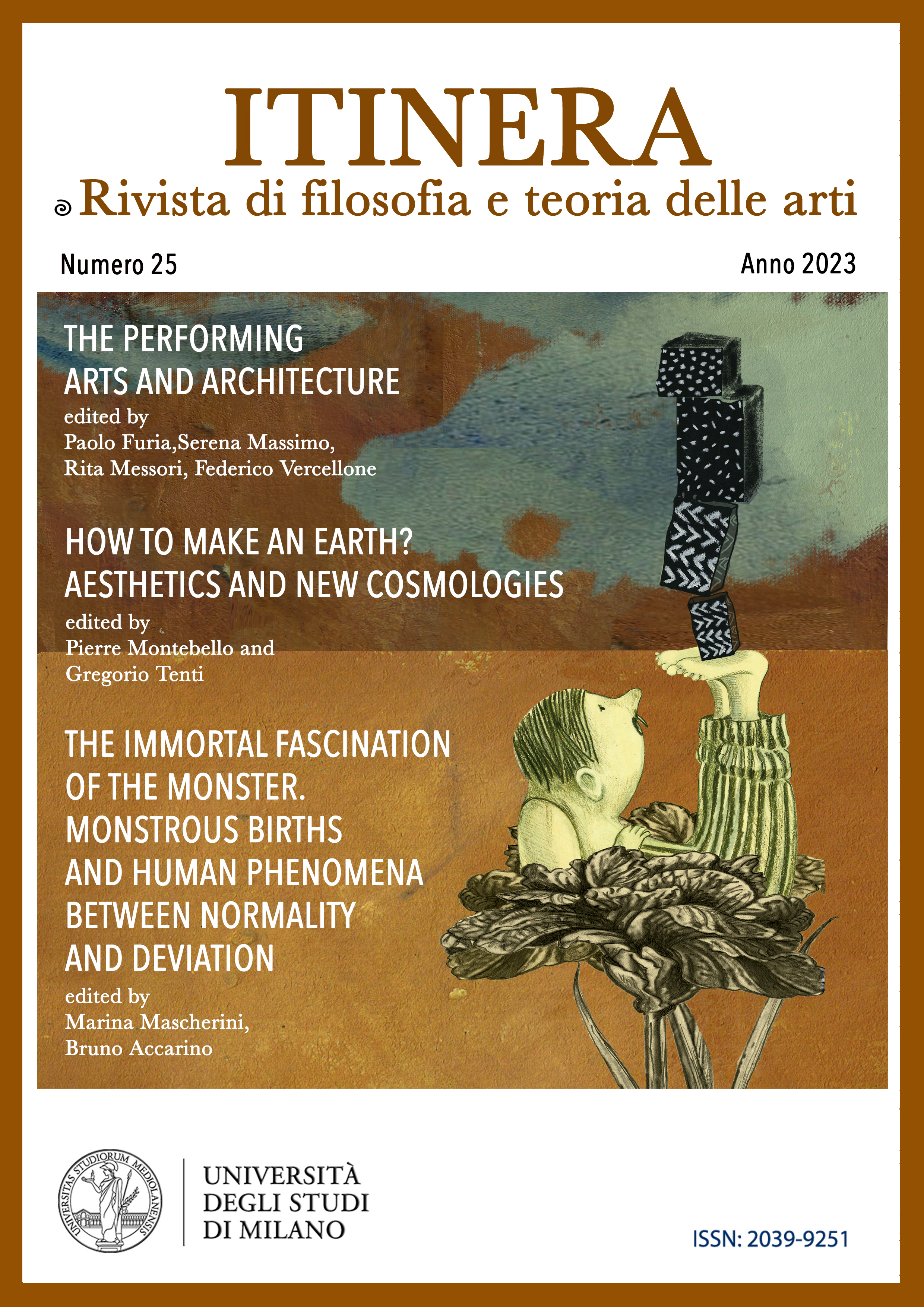From Flesh to Words and Back: How Performances Intervene in Space to Realise Rancière’s Politics
DOI:
https://doi.org/10.54103/2039-9251/20786Parole chiave:
Jacques Rancière, Ritual, Performance, Urbanism, Thresholds.Abstract
This paper inquires what kind of art best enhances what Jacques Rancière means by "politics". It argues that performance (theatre) and other types of artistic manifestations that include a performative component achieve what Rancière considers political equality. The paper argues on two fronts. First, it argues that artistic manifestations should not be understood as a special event, as understood in the traditional form of "ritual". Secondly, the paper takes this discussion to the question of the use of space in artistic manifestations. It is argued that performances should make a differential use of space, constituting spaces of categorical confusion, called thresholds, in order to better enhance Rancière's politics.
Riferimenti bibliografici
Aureli, P.V., The Possibility of an Absolute Architecture, Massachusetts Institute of Technology, Cambridge (MA) 2011.
Ballard, J. G., High-Rise, Holt, Rinehart and Winston, New York 1977.
Bassas, X., Jacques Rancière: Ensayar la Igualdad, Gedisa, Barcelona 2019.
Benjamin, W., The Work of Art in the Age of Mechanical Reproduction in Illuminations, Schocken Books, New York 1969.
Brenner, N., Critique of Urbanization: selected essays, Birkhäuser Verlag, Basilea 2017.
Caiazzo, C., Restructuring the Sensible Fabric: The Political as Aesthetic Space, in “Rivista di Studi Politici ‘Politics’”, n. 17(1) (2022), p. 71-86.
Corbusier, Le, The Athens Charter, Grossman Publishers, New York 1973.
Fischer-Lichte, E., The Transformative Power of Performance, Routledge, New York 2008.
García Espuche, A., La Gent del carrer Montcada (vol. 1), Ajuntament de Barcelona, Barcelona 2020.
Harvey, D., Smith, N., Capital financiero, propiedad inmobiliaria y cultura, Universitat Autònoma, Barcelona 2005.
Jameson, F., Postmodernism, or the Cultural Logic of Late Capitalism, Duke Univesity press, New York 1991.
Koolhaas, R., Junkspace. “October”, vol. 100 (2002), pp. 175-190.
May, T., The Political Thought of Jacques Rancière: Creating Equality, Edinburgh University Press, Edinburgh 2008.
Mouffe, C., The Democratic Paradox, Verso books, London 2000.
Quintana, L., Política de los Cuerpos, Herder, Barcelona 2020.
Rancière, J., A few remarks on the method of Jacques Rancière. “Parallax”, vol. 15:3 (2009a), pp. 114-123.
—, The Emancipated Spectator, Verso books, London 2009b.
—, What Does it mean to be Un, “Continuum”, 21 (2007), pp. 559-569.
—, Política, policía, democracia, LOM ediciones, Santiago de Chile 2006.
—, The Politics of Aesthetics: The distribution of the sensible, Continuum, New York 2004.
—, The Disagreement, University of Minnesota press, Minneapolis (MN) 1999.
Simmel, G., Bridge and Door, “Theory Culture Society”, 11:5 (1994). pp. 5-10.
Sontag, S., Los Happening: un arte de la yuxtaposición radical, in Contra la Interpretación, Alfaguara, Buenos Aires 1996, pp. 340-354.
Soto, A., La Performatividad de las Imágenes, Metales Pesados, Santiago de Chile 2020.
Stavrides, S., Towards the city of Thresholds, Common Notions, New York 2019.
Tilly, C., The Contentious French, Harvard University Press, Cambridge (MA) 1986.
Venturi, R., Learning From Las Vegas, MIT press, Cambridge (MA) 1988.
Dowloads
Pubblicato
Versioni
- 2023-08-17 (2)
- 2023-08-08 (1)
Fascicolo
Sezione
Licenza
Copyright (c) 2023 Oriol Martinez Alegria

Questo lavoro è fornito con la licenza Creative Commons Attribuzione - Condividi allo stesso modo 4.0.
Gli autori che pubblicano su questa rivista accettano le seguenti condizioni:
1. Gli autori mantengono i diritti sulla loro opera e cedono alla rivista il diritto di prima pubblicazione dell'opera, contemporaneamente licenziata sotto una Licenza Creative Commons - Attribuzione - Condividi allo stesso modo 4.0 internazionale che permette ad altri di condividere l'opera indicando la paternità intellettuale e la prima pubblicazione su questa rivista.
2. Gli autori possono aderire ad altri accordi di licenza non esclusiva per la distribuzione della versione dell'opera pubblicata (es. depositarla in un archivio istituzionale o pubblicarla in una monografia), a patto di indicare che la prima pubblicazione è avvenuta su questa rivista.
3. Gli autori possono diffondere la loro opera online (es. in repository istituzionali o nel loro sito web) prima e durante il processo di submission, poiché può portare a scambi produttivi e aumentare le citazioni dell'opera pubblicata (Vedi The Effect of Open Access).





